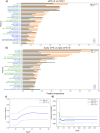A comprehensive and bias-free machine learning approach for risk prediction of preeclampsia with severe features in a nulliparous study cohort
- PMID: 39716098
- PMCID: PMC11667971
- DOI: 10.1186/s12884-024-06988-w
A comprehensive and bias-free machine learning approach for risk prediction of preeclampsia with severe features in a nulliparous study cohort
Abstract
Preeclampsia is one of the leading causes of maternal morbidity, with consequences during and after pregnancy. Because of its diverse clinical presentation, preeclampsia is an adverse pregnancy outcome that is uniquely challenging to predict and manage. In this paper, we developed racial bias-free machine learning models that predict the onset of preeclampsia with severe features or eclampsia at discrete time points in a nulliparous pregnant study cohort. To focus on those most at risk, we selected probands with severe PE (sPE). Those with mild preeclampsia, superimposed preeclampsia, and new onset hypertension were excluded.The prospective study cohort to which we applied machine learning is the Nulliparous Pregnancy Outcomes Study: Monitoring Mothers-to-be (nuMoM2b) study, which contains information from eight clinical sites across the US. Maternal serum samples were collected for 1,857 individuals between the first and second trimesters. These patients with serum samples collected are selected as the final cohort.Our prediction models achieved an AUROC of 0.72 (95% CI, 0.69-0.76), 0.75 (95% CI, 0.71-0.79), and 0.77 (95% CI, 0.74-0.80), respectively, for the three visits. Our initial models were biased toward non-Hispanic black participants with a high predictive equality ratio of 1.31. We corrected this bias and reduced this ratio to 1.14. This lowers the rate of false positives in our predictive model for the non-Hispanic black participants. The exact cause of the bias is still under investigation, but previous studies have recognized PLGF as a potential bias-inducing factor. However, since our model includes various factors that exhibit a positive correlation with PLGF, such as blood pressure measurements and BMI, we have employed an algorithmic approach to disentangle this bias from the model.The top features of our built model stress the importance of using several tests, particularly for biomarkers (BMI and blood pressure measurements) and ultrasound measurements. Placental analytes (PLGF and Endoglin) were strong predictors for screening for the early onset of preeclampsia with severe features in the first two trimesters.
Keywords: Ensemble model; Fairness in machine learning; Machine learning; PlGF; Preeclampsia; Preeclampsia with severe features.
© 2024. The Author(s).
Conflict of interest statement
Declarations. Ethics approval and consent to participate: Human subjects approval for this study, titled "SCH: Prediction of Preterm Birth in Nulliparous Women", was obtained following review by Columbia University Human Subjects Institutional Review Board, and the City University of New York CUNY Institutional Review Board. Competing interests: The authors declare no competing interests.
Figures






Update of
-
A Comprehensive and Bias-Free Machine Learning Approach for Risk Prediction of Preeclampsia with Severe Features in a Nulliparous Study Cohort.Res Sq [Preprint]. 2023 Apr 10:rs.3.rs-2635419. doi: 10.21203/rs.3.rs-2635419/v1. Res Sq. 2023. Update in: BMC Pregnancy Childbirth. 2024 Dec 24;24(1):853. doi: 10.1186/s12884-024-06988-w. PMID: 37090627 Free PMC article. Updated. Preprint.
Similar articles
-
A Comprehensive and Bias-Free Machine Learning Approach for Risk Prediction of Preeclampsia with Severe Features in a Nulliparous Study Cohort.Res Sq [Preprint]. 2023 Apr 10:rs.3.rs-2635419. doi: 10.21203/rs.3.rs-2635419/v1. Res Sq. 2023. Update in: BMC Pregnancy Childbirth. 2024 Dec 24;24(1):853. doi: 10.1186/s12884-024-06988-w. PMID: 37090627 Free PMC article. Updated. Preprint.
-
Can changes in angiogenic biomarkers between the first and second trimesters of pregnancy predict development of pre-eclampsia in a low-risk nulliparous patient population?BJOG. 2013 Sep;120(10):1183-91. doi: 10.1111/1471-0528.12128. Epub 2013 Jan 18. BJOG. 2013. PMID: 23331974 Free PMC article. Clinical Trial.
-
Prediction of Preeclampsia in Nulliparous Women according to First Trimester Maternal Factors and Serum Markers.Fetal Diagn Ther. 2020;47(4):277-283. doi: 10.1159/000503229. Epub 2019 Oct 17. Fetal Diagn Ther. 2020. PMID: 31622970
-
Combining Biomarkers to Predict Pregnancy Complications and Redefine Preeclampsia: The Angiogenic-Placental Syndrome.Hypertension. 2020 Apr;75(4):918-926. doi: 10.1161/HYPERTENSIONAHA.119.13763. Epub 2020 Feb 17. Hypertension. 2020. PMID: 32063058 Free PMC article. Review.
-
First trimester preeclampsia screening and prediction.Am J Obstet Gynecol. 2022 Feb;226(2S):S1071-S1097.e2. doi: 10.1016/j.ajog.2020.07.020. Epub 2020 Jul 16. Am J Obstet Gynecol. 2022. PMID: 32682859 Review.
Cited by
-
Reporting of Fairness Metrics in Clinical Risk Prediction Models Used for Precision Health: Scoping Review.Online J Public Health Inform. 2025 Mar 19;17:e66598. doi: 10.2196/66598. Online J Public Health Inform. 2025. PMID: 39962044 Free PMC article. Review.
-
Early Prediction of Hypertensive Disorders of Pregnancy Using Machine Learning and Medical Records from the First and Second Trimesters.medRxiv [Preprint]. 2024 Dec 3:2024.11.21.24317720. doi: 10.1101/2024.11.21.24317720. medRxiv. 2024. PMID: 39677418 Free PMC article. Preprint.
References
-
- Lockwood CJ, Moore T, Copel J, Silver RM, Resnik R, Dugoff L, Louis J. Creasy and Resnik’s Maternal-Fetal Medicine: Principles and Practice. Philadelphia: Elsevier. 2023;45:826–54.
-
- Sroka D, Verlohren S. Short Term Prediction of Preeclampsia, 2021.
MeSH terms
Substances
Grants and funding
LinkOut - more resources
Full Text Sources

